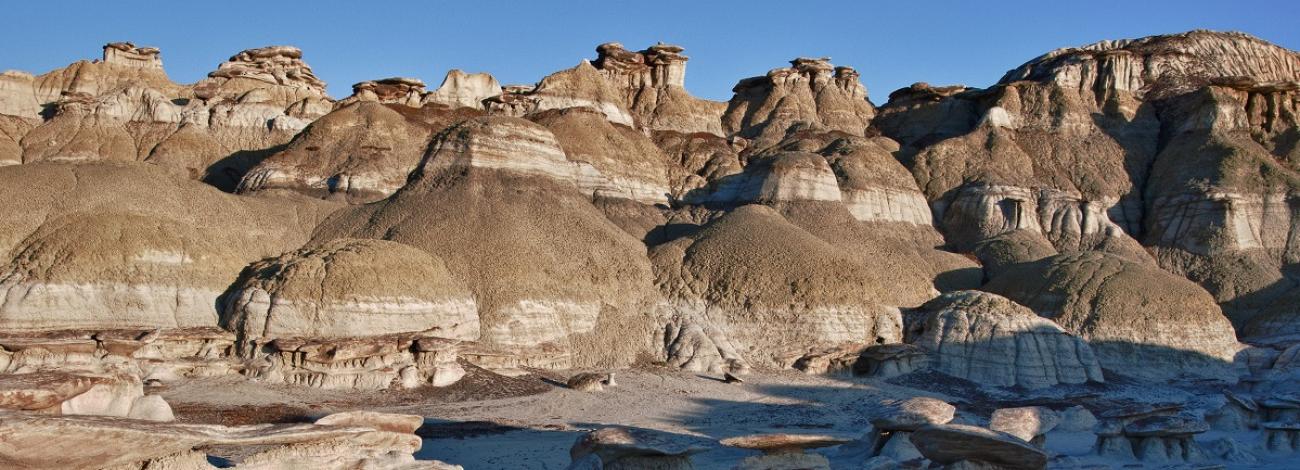
BLM New Mexico John D. Dingell, Jr. Act Designations
Overview
On March 12, 2019, President Trump signed Senate Bill 47 into law as Public Law 116-9, the John D. Dingell, Jr. Conservation, Management, and Recreation Act. This act will have an impact on public lands across the State of New Mexico. BLM New Mexico has been actively involved in the implementation of the law, and looks forward to working with local communities, counties and the State to implement the new land designations. The Act will help protect recreation opportunities and provide access to public lands by consolidating Federal and State lands. We invite you to explore the new recreation and national conservation lands designations.
National Conservation Lands Designations
- Ah-shi-sle-pah Wilderness
The 7,242-acre Ah-Shi-Sle-Pah Wilderness, located in northwestern New Mexico, is an area of rolling bentonite clay badlands with deep slot canyons cut from thousands of years of erosion. The delicate terrain is rich in fossils having yielded numerous paleontological specimens important to science. - Broad Canyon Wilderness
The 13,902-acre Broad Canyon Wilderness is well known for its steep red rock canyon walls that reach as high as 100 feet in some places, that follow along a sandy arroyo scattered with ash juniper trees and standing water pools. These walls lead you through parts of a slot canyon that reveal petroglyphs and rock shelters that house important cultural sites. - Cerro del Yuta Wilderness
The Cerro del Yuta Wilderness encompasses 13,420 acres that encircle the mountain. A volcanic cone jutting out of a high desert expanse, Cerro del Yuta is the highest point in the Río Grande del Norte National Monument at over 10,000 feet. - Organ Mountains Wilderness
The 19,916-acre Organ Mountains Wilderness is located in the rugged and scenic Organ Mountains-Desert Peaks National Monument. The area features massive, jagged spires, pinnacles, and outcroppings with steep, rocky ridges interspersed by narrow, rocky canyons. - Potrillo Mountains unit of the Organ Mountains-Desert Peaks National Monument
The Potrillo Mountains unit of the Organ Mountains-Desert Peaks National Monument is home to 6 different wilderness areas: the 27,673-acre Aden Lava Flow Wilderness, the 16,935-acre Cinder Cone Wilderness, the 12,155-acre East Potrillo Mountains Wilderness, the 8,382-acre Mount Riley Wilderness, the 105,085-acre Potrillo Mountains Wilderness, and the 9,616-acre Whitethorn Wilderness. The area offers visitors sandy areas, playas, lava fields, cinder cones, and volcanic craters. Visitors can make their way up Mount Riley for views of the nearby Aden Lava Flow which features large fields of lava flows and volcanic craters. - Río San Antonio Wilderness
The 8,120-acre Río San Antonio Wilderness is located in the northwest corner of the Río Grande del Norte National Monument. It consists of an open grass and shrub plain cut starkly by a narrow gorge about 100 feet deep, where Douglas fir and spruce line the Rio San Antonio. - Robledo Mountains Wilderness
The 16,776-acre Robledo Mountains Wilderness is characterized by rugged, steep canyons covered by desert grasses and shrubs. Robledo Mountain stands at an elevation of 5,866 feet. This Wilderness area spans both the Prehistoric Trackways and Organ Mountains-Desert Peaks National Monuments. - Sierra de las Uvas Wilderness
The 11,114-acre Sierra de las Uvas Wilderness offers a variety of landscapes of volcanic rock, cliffs, mesas, buttes, and deep canyons. The highest point is Magdalena Peak (elevation, 6,509 feet; prominence, nearly 2,000 feet).

